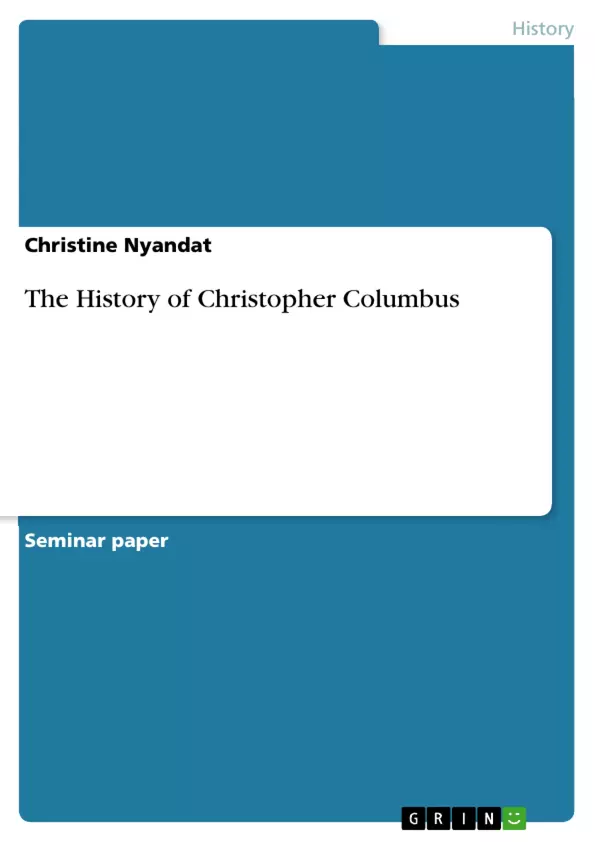Christopher Columbus, the explorer, made four trips across the Atlantic Ocean from Spain. His intent was finding a direct water path west from Europe to Asia. However, that never happened. Instead, he encountered the Americas. Although he never indeed discovered the New World, several persons were already living there. His voyage marked the start of centuries of North and South America colonization and exploration. The monarchy considered Columbus expedition as a chance to increase Spain’s commercial network into the Indies productive economy. Advocates of the catholic church, the empire likewise thought the voyage would be beneficial in spreading Christianity in the East.
Table of Contents
- Chapter 1: Columbus's Voyages and Their Impact
Objectives and Key Themes
This text aims to critically examine the traditional narrative surrounding Christopher Columbus and his voyages, challenging the celebratory portrayal often presented in schools and popular culture. It seeks to provide a more nuanced and accurate historical account, acknowledging the devastating consequences of European colonization for indigenous populations.
- The historical inaccuracies and biases in the traditional Columbus narrative.
- The brutal realities of colonization and its impact on indigenous peoples.
- The exploitation of indigenous populations through slavery and tribute systems.
- The ongoing debate surrounding Columbus Day and its replacement with Indigenous Peoples' Day.
- The need for a more inclusive and accurate representation of history in education.
Chapter Summaries
Chapter 1: Columbus's Voyages and Their Impact: This chapter details Columbus's four voyages across the Atlantic, highlighting the stark contrast between the intended goal of finding a westward route to Asia and the actual outcome of encountering and colonizing the Americas. It emphasizes the profound and devastating impact of Columbus's voyages, not as a moment of discovery, but as the initiation of centuries of exploitation, violence, and cultural destruction against indigenous populations. The chapter meticulously documents Columbus's role in establishing the transatlantic slave trade, implementing brutal tribute systems, and ultimately facing arrest for his cruelty. It contrasts the celebratory portrayal of Columbus in the United States with the growing movement to replace Columbus Day with Indigenous Peoples' Day, recognizing the suffering inflicted upon the original inhabitants of the Americas. The chapter also highlights the persistence of inaccurate and biased portrayals of Columbus in school textbooks, perpetuating a narrative that ignores the devastating consequences of European expansionism. The discussion of the lasting impact of Columbus's actions on the perception of history and the need for a more accurate and inclusive historical narrative forms a key element of this chapter's analysis.
Keywords
Christopher Columbus, colonization, indigenous peoples, slavery, exploitation, transatlantic slave trade, tribute system, historical inaccuracies, Indigenous Peoples' Day, Columbus Day, European expansionism, Taínos, Arawaks, Lucayans.
Frequently Asked Questions: A Critical Examination of Christopher Columbus and His Voyages
What is the main focus of this text?
This text provides a critical analysis of Christopher Columbus and his voyages, challenging the traditionally celebratory narrative and highlighting the devastating consequences of European colonization on indigenous populations. It aims to present a more nuanced and accurate historical account.
What are the key themes explored in this text?
Key themes include the historical inaccuracies and biases in the traditional Columbus narrative; the brutal realities of colonization and its impact on indigenous peoples; the exploitation through slavery and tribute systems; the debate surrounding Columbus Day and Indigenous Peoples' Day; and the need for a more inclusive and accurate representation of history in education.
What does the text say about Columbus's voyages?
The text details Columbus's four voyages, emphasizing the devastating impact on the Americas. It highlights the contrast between the intended goal (finding a westward route to Asia) and the reality (colonization and exploitation). The text meticulously documents Columbus's role in establishing the transatlantic slave trade and implementing brutal systems of tribute.
How does the text address the traditional portrayal of Columbus?
The text directly challenges the celebratory portrayal often found in schools and popular culture. It exposes the historical inaccuracies and biases that have perpetuated a misleading narrative, ignoring the suffering inflicted upon indigenous populations.
What is the significance of the debate surrounding Columbus Day and Indigenous Peoples' Day?
The text examines the ongoing debate, using it as a lens through which to understand the lasting impact of Columbus's actions and the need for a more accurate and inclusive historical representation. It highlights the contrast between celebrating Columbus and acknowledging the suffering of the indigenous populations.
What is the text's conclusion regarding historical accuracy and education?
The text strongly advocates for a more accurate and inclusive representation of history in education, emphasizing the need to challenge biased narratives and acknowledge the devastating consequences of European expansionism on indigenous communities. It underscores the importance of moving beyond simplistic and celebratory accounts of historical events.
What are some of the keywords associated with this text?
Keywords include Christopher Columbus, colonization, indigenous peoples, slavery, exploitation, transatlantic slave trade, tribute system, historical inaccuracies, Indigenous Peoples' Day, Columbus Day, European expansionism, Taínos, Arawaks, and Lucayans.
What is covered in Chapter 1?
Chapter 1, "Columbus's Voyages and Their Impact," details Columbus's four voyages, highlighting the devastating consequences of his actions on indigenous populations. It contrasts the intended goal of finding a westward route to Asia with the reality of colonization and exploitation, emphasizing the brutality and lasting impact of his voyages. The chapter also discusses the ongoing debate surrounding Columbus Day and Indigenous Peoples' Day and the persistence of inaccurate portrayals in school textbooks.
- Quote paper
- Christine Nyandat (Author), 2020, The History of Christopher Columbus, Munich, GRIN Verlag, https://www.grin.com/document/922957



